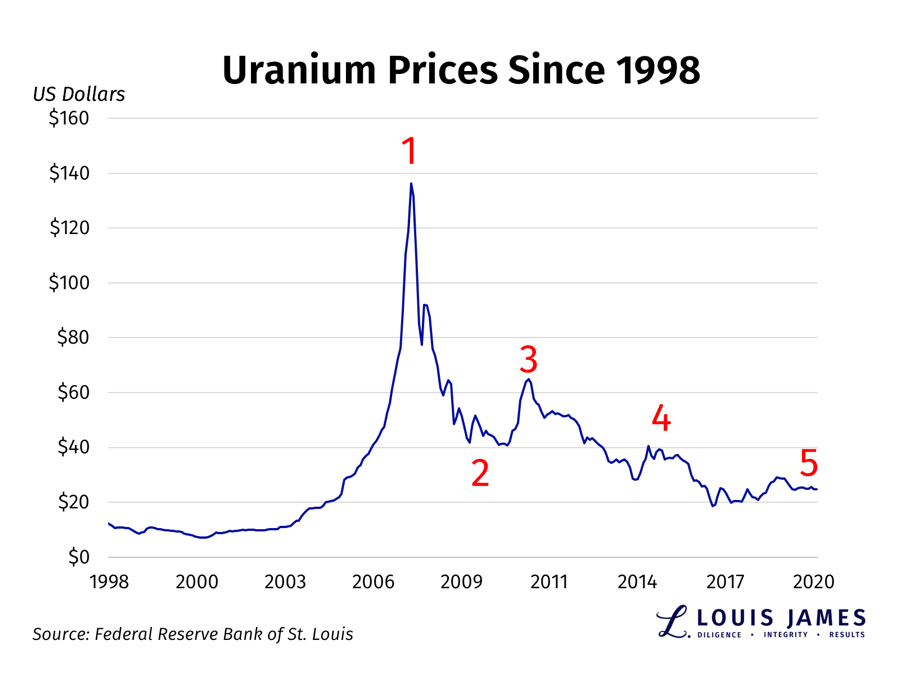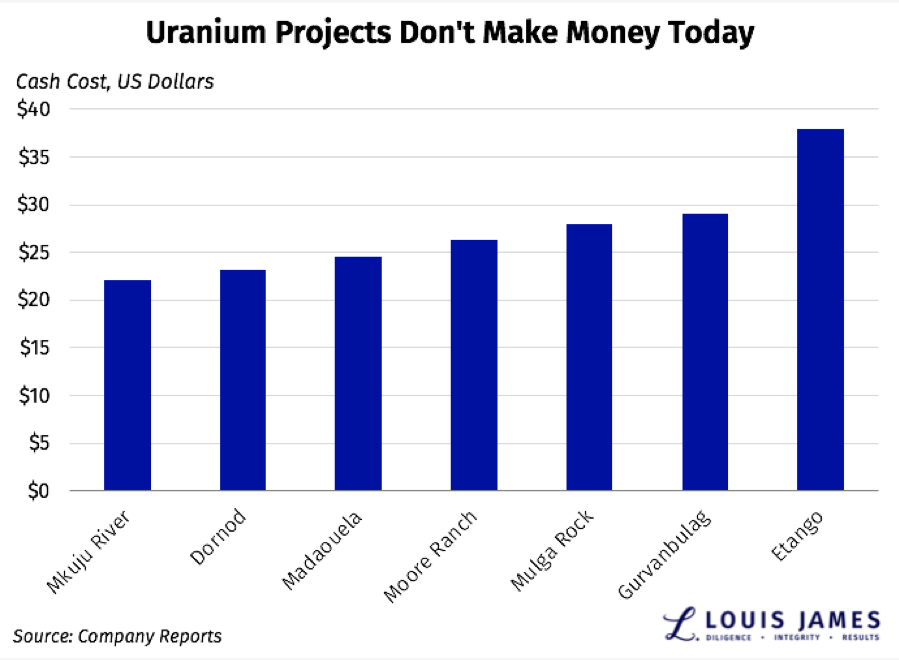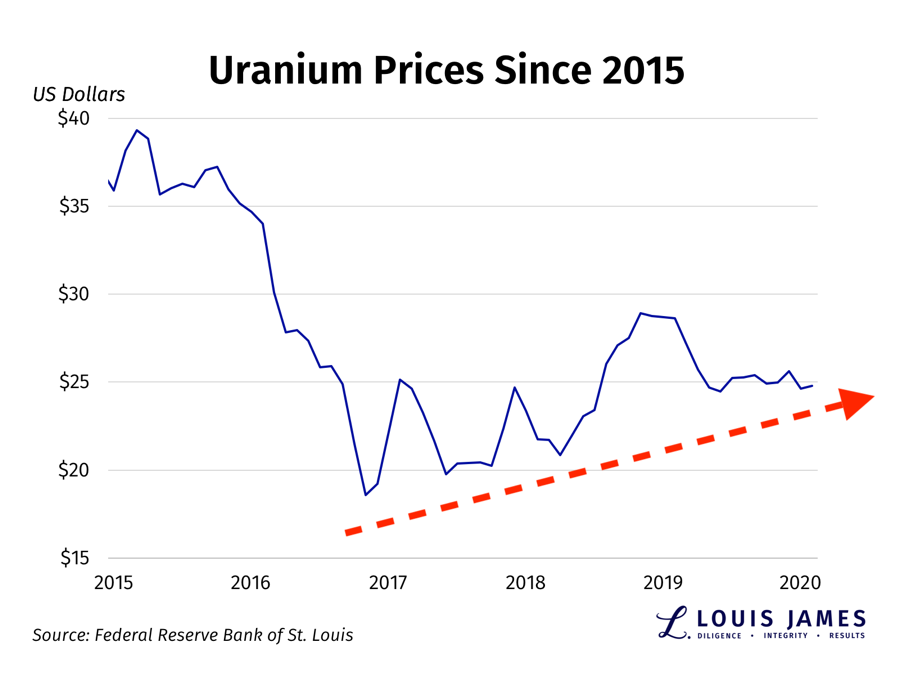If you want a shot at 10x, 20x, or even 100x winners over the next year or two, you have to look into speculating in the junior uranium sector.
I’m not saying that it’s safe, easy, or even likely.
The question you have to ask is: “Am I willing to risk significant losses in order to bag a potentially life-changing win?”
To explain why my own answer is “yes,” let me first give you a bit of background.
Uranium Price History

- In the first decade of this millennium, the world woke up to the fact that it needs nuclear power. The entire conversation shifted as people of different political bents around the globe realized that nuclear reactors don’t dump carbon into the atmosphere, they run 24/7/365, and can be built in any country. China—one of the world’s worst polluters for decades—understood that it has a serious problem and it needs to stop burning so much coal. It was a great, true story, and uranium prices went vertical in 2007.
- But it was too much too fast. Uranium prices corrected dramatically. That was no surprise and a reasonable market response. Prices fell to near the average cost of production, around $40.
- The pro-uranium narrative took hold again. China announced plans to build scores of nuclear power plants. Other countries followed suit. Prices started soaring. Then a tsunami struck the Fukushima nuclear power station in Japan, causing the worst nuclear accident since Chernobyl. Uranium prices stopped rising abruptly and went on a multi-year slide.
- Prices were down, but the narrative remained strong. Germany decided to move away from nuclear power, but more reactors were being built worldwide than were shut down. Even the Japanese found that they had to have nuclear power and will need it for decades to come. Prices rallied again, but then started falling as cash-strapped Japanese utilities sold excess uranium stocks they weren’t going to need for years. This relentless selling pushed spot uranium prices well below the cost of mining the stuff.
- The narrative hasn’t changed. The world still needs nuclear power plants. China, India, and other countries are building scores of them. Even the US is looking to build its first new plants in decades. It seems like a weekly occurrence now that some climate-change warrior or another realizes that international carbon-emission reduction goals aren’t going to be met without help from nuclear power. But uranium prices continue scraping along well below the cost of production.
This brings us to now. It’s a terrible time to be a uranium miner. And that means it’s a great time to be a uranium speculator.
Why Uranium Prices Must Rise
The key facts are:
- Uranium cannot be substituted for in less than decades.
- Uranium cannot be mined profitably at current prices.
The world’s uranium producers are in dire shape. Even the best of them—Cameco and Kazatomprom—are shutting down production in response to lower prices. That includes flagship mines like Cameco’s high-grade McArthur River mine in Canada.
Uranium is selling so cheap, miners with long-term contracts at higher prices are buying uranium at spot and selling to their customers instead of mining. As crazy as it sounds for uranium producers to be buyers, it makes more sense than spending more money to deplete their assets in the ground.
This cannot and will not last.
Even the companies with the best new projects are in no hurry to advance them toward production.

Note that the cost per pound of production in the chart above is a cash cost figure, not an all-in cost. You can add 50–100% to the bars above and still get a conservative estimate for how high uranium prices would have to go for these projects to become profitable.
Meanwhile, the two facts remain: the world needs uranium; and it’s not going to get it at current prices. Something needs to give.
But why do I think uranium’s dawn is finally here? In part, it’s the most recent price action. Let’s zoom in on the last couple years.

As you can see, the last high is higher than the two previous peaks. Perhaps more significantly, we’ve seen higher lows since the bottom as well. Uranium prices would need to remain stagnant for the rest of this year to break the bottom trendline.
A critical fact regarding the state of the market today is that the Japanese have announced plans to restart a score of their nuclear power plants now. Even more important is that uranium miners with high-price sales contracts, like Cameco, have tried to buy excess Japanese uranium and have not been able to.
This suggests that the excess supply that dragged uranium prices so low is no longer a factor.
And then there’s the new US move toward supporting domestic production which could help. The governor of Wyoming has said that Trump will include $150 million in his budget proposal for this year to boost US production. That’s peanuts in the bigger scheme of things, but if it enables US producers to contract at higher prices, it could impact the overall market. Unfortunately, Congress would have to approve this budget, so nothing may come from it, but it is a potential tailwind.
There’s one more thing. Like it or not, Donald Trump has pulled the US out of anti-nuclear weapons treaties with Russia. Both sides are embarked on a new buildup of undisclosed proportions. I can’t say what this will do to existing stockpiles on both sides, or to global demand, but it could be bullish for uranium prices. It sure won’t be bearish anytime soon.
Be that as it may, the fundamentals couldn’t be stronger.
Climate Change to the Rescue
I was fascinated last year when I stumbled on Michael Shellenberger’s talks in favor of nuclear power. This guy isn’t some corporate industry shill. He’s a hardcore environmentalist. He also happens to think that the truth matters. His talk on how fear of nuclear power was engineered—and how it may end—is truly moving.

In a talk on nuclear power, Shellenberger shows a photo of a whale he saw breaching in front of the Diablo Canyon nuclear power plant in California.
But the important thing is that Shellenberger is not alone. If you simply type “nuclear power” into the search tool on YouTube, you get a screen full of links to videos that are neutral or positive. More and more people are at least willing to consider the question, rather than close their minds to any possibility that past fearmongering might be wrong.
That’s great, but what really caught my attention was when NPR reported on the 40th anniversary of the Three Mile Island accident—and suggested in that article that the world might need nuclear power after all. Quite striking, given the source.
The cherry on top was to see an op-ed in the New York Times, that bastion of liberal media bias, arguing that climate change requires the world to embrace nuclear power.
If the climate-change movement turns pro-nuclear and the world pivots back to nuclear energy, it will take uranium prices higher for year and years to come.
What are the odds? Hard to say. It seems to me that there’s a growing feeling of panic among climate-change activists as they realize that the world isn’t on track to meet its carbon reduction goals. As the reality that that nothing else can deliver the carbon-free energy needed, we could see them demand more nuclear power.
But even if this never happens, it will be decades before enough alternative energy resources can be developed. And people will still want their lights to turn on at night.
That’s why I’m convinced that with or without help from climate-change warriors, uranium prices will rebound and head higher.
Even a Recession Won’t Stop This
Another very important point is that uranium’s fundamentals are highly insulated from the general drivers of the commodities markets. The slowing global economy may be bad for oil and gas as people travel less, and so forth. But nuclear power is used for base-load energy. And even in a cooling economy, people will still want the lights to come on at night.
Utilities are not contracting for new supply from miners, as is.
A slowing economy can’t take the rate of new contracts below zero.
Whatever happens with the trade wars, real wars, viral outbreaks, or other black swans—this won’t change.
Uranium remains below “stupid cheap.” Going forward, it has more upside than downside. All of its indicators are pointing upward.
There’s significant potential for near-term weakness in other industrial metals and resources, but uranium is on its own trend path—and it’s upward.
What Could Go Wrong
As bullish as all this makes me, I have to also say that speculating on anything uranium-related could still go horribly wrong.
All it would take is another nuclear accident.
One could argue that the only really bad nuclear accident there’s been was Chernobyl. And that wouldn’t have been so bad, if not for Soviet mismanagement. The Three Mile Island incident caused a lot of panic and changed the course of nuclear energy in the US, but there was no nuclear wasteland. In fact, the plant remained in operation, only recently shutting down for good. And at Fukushima, it was the tsunami that killed almost all of the people. The Japanese did an admirable job of containing the damage despite such a challenging circumstance. And none of these types of accident will be repeated.
But people aren’t rational on this subject. I don’t want to sugarcoat this.
It’s possible to lose almost every dollar you put into uranium stocks, if things go wrong.
That said…
If You Can Handle the Risk, There’s HUGE Potential
It’s well-documented that price movements in minerals, metals and other commodities are magnified in the share prices of related companies. If gold rises 1% one week, gold miners will typically rise 3%-5% that week. The same holds true for copper, oil, and other resource commodities.
So what happens if uranium prices rise from their current level, near $25 per pound, to the global average cost of production, which is around $40 per pound?
That huge move in the underlying commodity would be magnified in the price of uranium stocks.
But remember that this is just the cost of production. You still need to explore for the stuff, build mines, sell your product, and so forth. Most feasibility studies for uranium projects use an “incentive cost” price assumption of $60–$70 per pound.
Consider what would happen to the price of most uranium stocks if the price of uranium itself doubled or tripled as needed to incent new mine development.
And then there’s the fact that the last time we saw a major spike, it took uranium up to almost $140 per pound—not adjusted for inflation. The next spike could dwarf that last one.
It wouldn’t last, but if uranium prices broke the charts, leveraged uranium stocks would go through the roof.
Think I’m exaggerating?
Look what happened to one tiny uranium stock that made it big during the last big spike: Paladin Energy.

I am not promising gains like this to anyone.
I am saying that it’s possible—it’s happened before.
This is why, despite the risks, I’ve speculated on what I consider to be the best stocks in the sector.
Buy Low, Sell High
Best of all is that most of the quality uranium plays on the market today are still selling dirt cheap. That’s a clear contrarian opportunity. I know it takes courage, but if you want to swing for the bleachers on a big win, this is an opportunity you owe it to yourself to consider.
Which uranium stocks do I like best? With respect, that’s what readers of The Independent Speculator pay to know. You’re welcome to subscribe and put my experience to work on your behalf.
But you now have my take on the market. You can conduct your own due diligence and place your own bets.
I see so much potential in this, I’m willing to help you, free of charge—in hope that you’ll remember my guidance in the future.
I recently wrote an evaluation of 15 frequently asked about uranium stocks. None have changed materially since then. You’re welcome to download my take on 15 uranium companies today, for free.
Either way, stay disciplined in your diligence and decisions, and if uranium goes where I think it’s going, I’m sure you’ll do very well.
![]()

